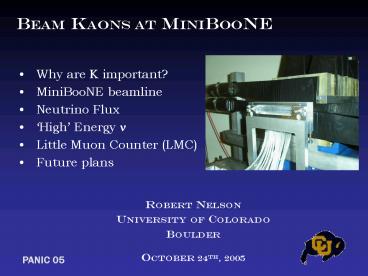Beam Kaons at MiniBoone
1 / 13
Title: Beam Kaons at MiniBoone
1
Beam Kaons at MiniBoone
- Why are K important?
- MiniBooNE beamline
- Neutrino Flux
- High Energy n
- Little Muon Counter (LMC)
- Future plans
- Robert Nelson
- University of Colorado
- Boulder
- October 24th, 2005
2
K are money
- Intrinsic ne from K are on the same order as our
expected signal. - The focus of this talk will be on understanding
our K background. - We would like to know this background to lt10
uncertainty.
Assuming 1021 p.o.t. Dm2 0.4-1.0 eV2
3
MiniBooNE Beamline
Primary beam 8 GeV protons
Secondary beam
Neutrino beam
LMC enclosure
- 70 cm/1.7 l Be target.
- 80 bunches in a 1.6 ms beam spill (5E12 ppp).
- 140 ms pulsed (2-5 Hz) 170 kA horn.
- Focus (-) mesons for n(n-bar).
- 50/25 m decay region.
- 450 m dirt before the detector.
Target and Horn
Bartoszek Engineering
4
Intrinsic ne Neutrino flux
- The expected flux of ne from K is on order of the
possible oscillation signal. - This flux needs to be well understood.
- From dead reckoning and internal constraints.
preliminary
5
Dead Reckoning our s(pBe?KX)
- We use many sources of external data to cover our
parameter space in a Sanford-Wang fit. - No single data set covers our entire range, or
theyre at different C.O.M. energies. - Some inconsistencies lead to a less then ideal
fit. - While this data is useful we want HARP data on a
replica MiniBooNE target at our beam energy (see
the HARP talk later). - We also perform internal measurements to
constrain the S-W fit.
6
Why use an off axis beam monitor?
- The nm flux are mostly from p.
- High energy n in the tank can only come from K
decays. - However, we would like to probe the entire
kinematic region. - Daughter m from K decays are kinematically
different then those from p. - Fixed angle off-axis leads to a separation in
energy. - We would like to study low energy n from K as
well. - The LMC can probe this space.
preliminary
7
The Little Muon Counter
- Located 70 off-axis of the secondary meson beam.
Chosen to optimize coverage of phase space. - Optimized between 0.2-3 GeV/c, measures sign.
- System consists of
- Steel/W collimator (ensures clean signal).
- Veto (removes particles that scatter through the
collimator). - Fiber tracking hodoscope (measures a charged
particles momentum). - Acceptance counters (fixes tracks to active
region of tracker). - W/Scintillator range stack (used for PID) .
8
The Little Muon Counter at Home
9
What should things look like?
- Ideally there should be a good separation between
m from p and m from K. - Detector resolution and multiple scattering not
included. - Fluctuations from MC statistics.
- Possible background from m scattering in the
dirt, the collimator reduces them.
Monte Carlo
Energy of m (GeV)
10
Track Reconstruction MC/Data
Range Stack (not to scale)
m acc. (not to scale)
Bend planes
cm
MC
Data
500 MeV muon
p candidate
Position in fiber space (x0.5mm)
beam
11
Internal Constraints on s
- The LMC (blue) covers a significant chunk of the
phase space (black). - High energy tank n (red) come only from K and
depend on n s. - These measurements complement and overlap each
other.
12
Path to a result
- We are current accumulating LMC data.
- We are working to understand our m backgrounds
better. - Finally, we fit the normalizations of the MC
distributions to extract a K s constraint for use
in our ne prediction. - Our goal is a 5-10 s(pBe?KX) uncertainty.
13
(End of talk)Thank You!































